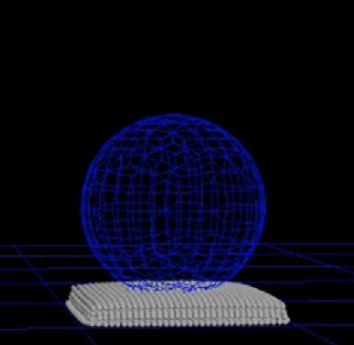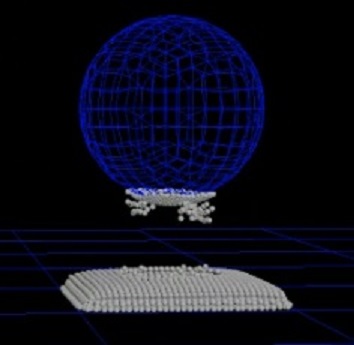| On this page |
The VDB Collider SOP defines VDB colliders to bounce or kill dynamic objects, such as particles. It has fast substepping on the GPU and has an easy SOP-based setup. It can be used by the
MPM Solver and
Vellum Solver in the context of a simulation and can either create a VDB from a mesh or be provided with one directly.
Advantages ¶
-
SOP based for easy viewing, manipulation, and merging of colliders.
-
Fast and accurate (GPU) interpolation using velocity fields.
-
Controls for other effects such as Friction, Sticky, Bounce, Delete, etc.
-
Merge multiple
VDB Colliders into one stream before feeding them into the
Vellum Solver.
Limitations ¶
-
Computing this creates a huge chunk of OpenCL code that takes a very long time to compile. This results in very slow compile times the first time you run the simulation (sometimes several minutes).
Note
You will see a notification at the bottom of the status bar that says Compiling OpenCL kernels along with a timer to indicate something is happening and Houdini isn’t frozen.
Tip
You can press ⎋ Esc to stop the compile at any time.
-
Potentially high GPU memory use for very high resolution deforming objects.
Collider types ¶
There is a Collider Type parameter that allows you to choose between 3 collider types: static, transforming, or deforming.
| To... | Do this |
|---|---|
|
Set up a static collider |
Set the Collider Type is set to Static. This is the default VDB Collider, as it is the most efficient. It is represented by a single VDB |
|
Set up a transforming collider |
This is the most efficient of the animated colliders and it is extremely accurate as the transformation is interpolated between frames for each substep. It is represented by a single VDB along with a transformation matrix. Only the rigid transformation is updated per frame as the VDB |
|
Set up a deforming collider |
This should only be used over the Animated (Rigid) type when actual deformation is taking place, as it is the most expensive of the two. It is represented by a pair of |
Collision behavior ¶
The Collision Response parameter allows you to control what happens when the dynamic object makes contact with the collider. Bounce will bounce or stop the dynamic object depending on its material type, and Delete will remove the dynamic object’s points. This can be used to dynamically cut the material as the simulation runs without resistance.
Turing on the Inverted SDF checkbox allows you to invert the sign of the VDB surface to simulate the dynamic object trapped inside the collider.
The Sticky parameter allows projection of the dynamic object’s velocity even when moving away from the collider surface. This prevents the dynamic object from detaching from the collider, making it sticky if Friction is high enough. The following images show a sticky sphere dipped into a bed of particles and then lifted up with particles sticking to it.


Fluids and grains ¶
VDB Collisions are intended for use with the minimal solver, and is well suited for grain and fluid simulations.
Vellum Fluid simulations can take VBD collisions into account when solving for viscosity and surface tension, giving improved wetting effects when used with this style of collision. Vellum Grain simulations can take VBD collisions into account when solving for friction and stickiness, giving improved sticking and sliding effects when used with this style of collision.
For more information, see Minimal mode.